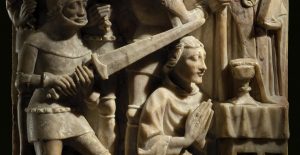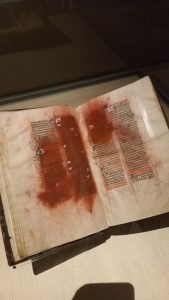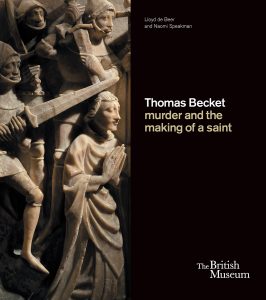 The Thomas Becket exhibition at the British Museum
The Thomas Becket exhibition at the British Museum
There are two interesting revelations at this intelligently curated show marking the 900th anniversary of Thomas Becket’s birth – well it would have been the 900th anniversary last year but the show got delayed due to corona. And it’s the death that gets all the attention.
.
The first is the extent to which Thomas’s murder at the order – or suggestion – of Henry II made him a European as well as an English martyr. Many of the objects on show, the reliquaries and statues, come from countries like Norway and Sweden where he was venerated; the Christian faithful from those countries arrived in large numbers and took the pilgrimage to Canterbury not from London, as Chaucer did, but from Southampton along the south coast, a longer route which would show they were more devout. It is a journey that the British Pilgrimage Trust is trying with some success to revive to emulate the Compostela pilgrimage in Spain, so popular for those of many faiths. They are calling it The Old Way.
.

Why the traditional pilgrimage to Thomas Becket’s shrine ever died out in the first place is the second great revelation of this show. For 300 years, Becket‘s was one of the great pilgrimage routes of Europe, to equal Compostela and even Rome. It is estimated that millions of pilgrims took it over the centuries.
But then came Henry VIII and the Reformation. With the brute force that he was to show in so many religious matters, Henry VIII cancelled Thomas Becket. No one was allowed to follow the pilgrimage anymore; and Becket’s own memory was defamed. Some of the most moving of the exhibits are the books from which pages have either been removed or defaced to obliterate the story of ‘this troublesome priest’.
Henry VIII had quite enough trouble on his hands from contemporary clergy like Thomas More; he didn’t want a dead one haunting his footsteps as well. Moreover Becket’s rich shrine could provide him with yet more pickings to add to those from the monasteries. He sent his men down to Canterbury in 1538 to enforce the destruction. They even destroyed Becket’s bones in their casket. The irony can not have been lost on Henry’s critics: again a king was taking it into his own hands to enforce religious observation.
.
 I have a personal reason for being interested in the exhibition in that I proposed following the pilgrimage route along the South Downs as a radio series for BBC R4, with the help of Will Parsons, who has been one of the people instrumental in reviving the route. Sadly, we didn’t get to make the series, although we came close; but Will is in the process of writing a book which he will bring great charm and enthusiasm to, as with this essay. It was Will for instance who told me that Thomas Becket was born on a Tuesday which is why his life was so full of grace. See his website about wayfaring across Britain – and do also see this fine exhibition, which is an excellent way of reopening the British Museum after lockdown. Hats off to the curators for showing an entire stained glass window from Canterbury Cathedral as the stunning centrepiece.
I have a personal reason for being interested in the exhibition in that I proposed following the pilgrimage route along the South Downs as a radio series for BBC R4, with the help of Will Parsons, who has been one of the people instrumental in reviving the route. Sadly, we didn’t get to make the series, although we came close; but Will is in the process of writing a book which he will bring great charm and enthusiasm to, as with this essay. It was Will for instance who told me that Thomas Becket was born on a Tuesday which is why his life was so full of grace. See his website about wayfaring across Britain – and do also see this fine exhibition, which is an excellent way of reopening the British Museum after lockdown. Hats off to the curators for showing an entire stained glass window from Canterbury Cathedral as the stunning centrepiece.
